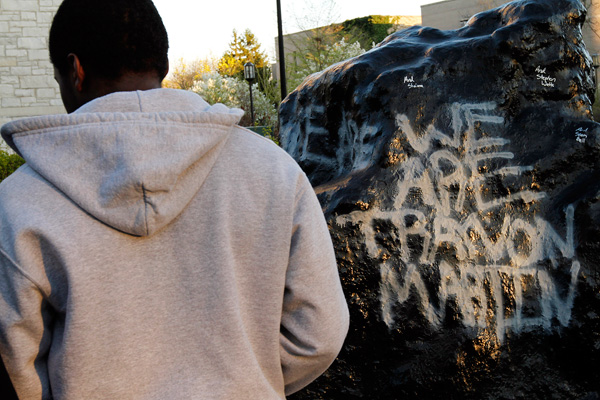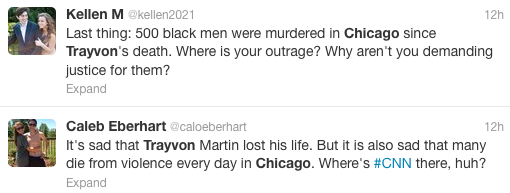
Photo: Phil Velasquez/Chicago Tribune
A rally and march for Trayvon Martin, Northwestern University, March 28, 2012
As soon as the George Zimmerman verdict was announced, I knew it would come pouring forth—no, not riots, but the abundant question of why an outlier case like Zimmerman's shooting of Trayvon Martin is granted wall-to-wall coverage, and not the violence in Chicago.

How'd I know? I have a short piece on this in the magazine this month, online in a bit, about how Chicago is, contrary to the assumption that the media is ignoring problems here, the media's current urban punching bag. Which is fine; it happens. As Bill Savage reminded me, 30 years ago New York was a prominent symbol of urban decay ("Warriors… come out and plaaaay"), a fearsome city that had nearly gone bankrupt. Now Times Square is Disneyland. 20 years ago it was Los Angeles, in the wake of the riots. Now it's Chicago's turn. Houston should be preparing its defense anytime now.
Savage also pointed out that the president came out of Chicago politics; his chief political advisor came out of Chicago politics and political journalism; one of his former chiefs of staff was a Chicago politician and the current mayor; and a second chief of staff is the brother of a Chicago mayor and is now a gubernatorial candidate (in the wake of Madigan's decision yesterday, arguably the front-runner). It's entirely reasonable to ask what they learned here and what they took from here to the national scene, as well as vice versa.
Of course, it's frustrating as well. Indianapolis's violent crime rate is way up this year. Philadelphia's spiked last year; fortunately, as of June, it had fallen this year. The highest rate of black homicide in the country, by state? Missouri, followed by Pennsylvania; Indiana is #6. Illinois, in 2010, wasn't in the top 10. Lots of cities share Chicago's problems; in the past year or so, Chicago's gotten the focus. It's not wrong, exactly, but it is limiting.
So it's not exactly true that the "media" is ignoring Chicago's problems. It's been the subject of cover stories in The Atlantic, Time, and the New York Times Magazine, an HBO documentary, and countless other pieces. (The better question, instead of "Why is the media ignoring Chicago?" might be "Why are you getting your news from CNN?") But there are compelling reasons why the Zimmerman trial consumed so much oxygen.
1. Concealed carry and gun culture.
George Zimmerman is a worst-case scenario for concealed carry, or something close to it: a paranoid man tracks down a teen minding his own business on a dark night in a suburb; the fight that results, rather than ending in an assault, which would be bad enough, ends in a killing. Zimmerman is an extreme outlier; as Steve Chapman points out, "since 2007… 516 people have been killed by permit holders," one-quarter of those being suicides. But in cases of life and death, people are going to be conscious of extreme outliers.
2. Homicides are decreasing in urban areas, and increasing in suburban ones.
The story of urban crime has been one of frustratingly slow success—save for, perhaps, New York, where success has come faster—but success nonetheless. In recent years, however, the decline in homicide rates in urban centers has been paralleled by an increase in big-city suburbs:
U.S. homicides fell sharply from 2001 to 2010, including a 16.7% drop in big cities, according to a federal Bureau of Justice Statistics study of the most recent, reported data. That is because of a host of factors, including better medical treatment for victims of violent injury and aggressive police measures in megacities like New York and Los Angeles.
But homicides rose 16.9% in suburbs during the same period, according to the BJS. This came during a time when populations in both large cities and suburbs grew substantially.
Today, suburban murders, from domestic violence to robberies gone bad to massacres like the Newtown, Conn., school shootings, make up about a quarter of all homicides in the U.S., up from 20.7% in 2001, according to the BJS. The sharpest increases in violent crime appear to be in suburbs of cities, including those of Houston, Pittsburgh, and Atlanta. The violent-crime rate in Atlanta's suburbs rose 23% between 2000 and 2008, while the city of Atlanta's violent-crime rate dropped 49%, according to federal crime data in a May 2011 study by the Brookings Institution, a nonpartisan think tank in Washington.
Chicago, for all its problems, is a big city with a large budget and a massive, experienced police force. What do you do if you're Sauk Village or Glenview? Not much: "On Dec. 7, sheriff’s officers spent about three hours patrolling Sauk Village and making street stops. Even though their legal responsibility is to patrol unincorporated areas, they work in such towns because budget problems have limited the ability of the towns to patrol themselves."
Sanford, Florida, where George Zimmerman shot Trayvon Martin, has comparatively high rates of poverty, a moderately high violent crime rate, and a burglary rate twice the national average; it's also dealt with tension over the dispersal of public-housing residents, and residential instability following the crash of the housing market, which hit Florida particularly hard. These are all elements of social tension, which makes for good ratings—for good and bad.
3. Racial profiling.
As mentioned before (and in a million other places), the collapse of violent crime in New York City—which, 30 years ago, could have plausibly expected a future like Detroit's present—is one of the most significant and mysterious stories in criminal justice and urban history. And it's widely attributed, as in the instance above, to "aggressive police measures." What does the mayor of New York think about those aggressive police measures?
“There is this business, there's one newspaper and one news service, they just keep saying, 'Oh it's a disproportionate percentage of a particular ethnic group,' " he went on. "That may be, but it's not a disproportionate percentage of those who witnesses and victims describe as committing the murder. In that case, incidentally, I think we disproportionately stop whites too much and minorities too little.”
As Justin Peters writes, about 10 percent of stop-and-frisk subjects are "based on a description of a violent crime suspect"; a similar percentage are actually guilty of something. Proponents of stop-and-frisk contend that the same minorities who are disproportionately the subjects of stop and frisk also benefit from it the most, in the form of declining violent crime. But how much freedom—the freedom to be in a public place without being treated as a potential suspect by police or one's own neighbors—are people willing to give up? And who makes that decision?
When the subject of racial profiling comes up, I always think of Brent Staples's masterful essay "Mr. Bellow's Planet," his account of being a black graduate student in Hyde Park:
I held a special contempt for people who cowered in their cars as they waited for the light to change at 57th and Woodlawn. The intersection was always deserted at night, except for a car or two stuck at the red. Thunk! Thunk! Thunk! They hammered down the door locks when I came into view. Once I had hustled across the street, head down, trying to seem harmless. Now I turned brazenly into the headlights and laughed. Once across, I paced the sidewalk, glaring until the light changed. They'd made me terrifying. Now I'd show them how terrifying I could be.
What happens when the suspicions of individual actors becomes public policy—and if it works, is it worth it?


